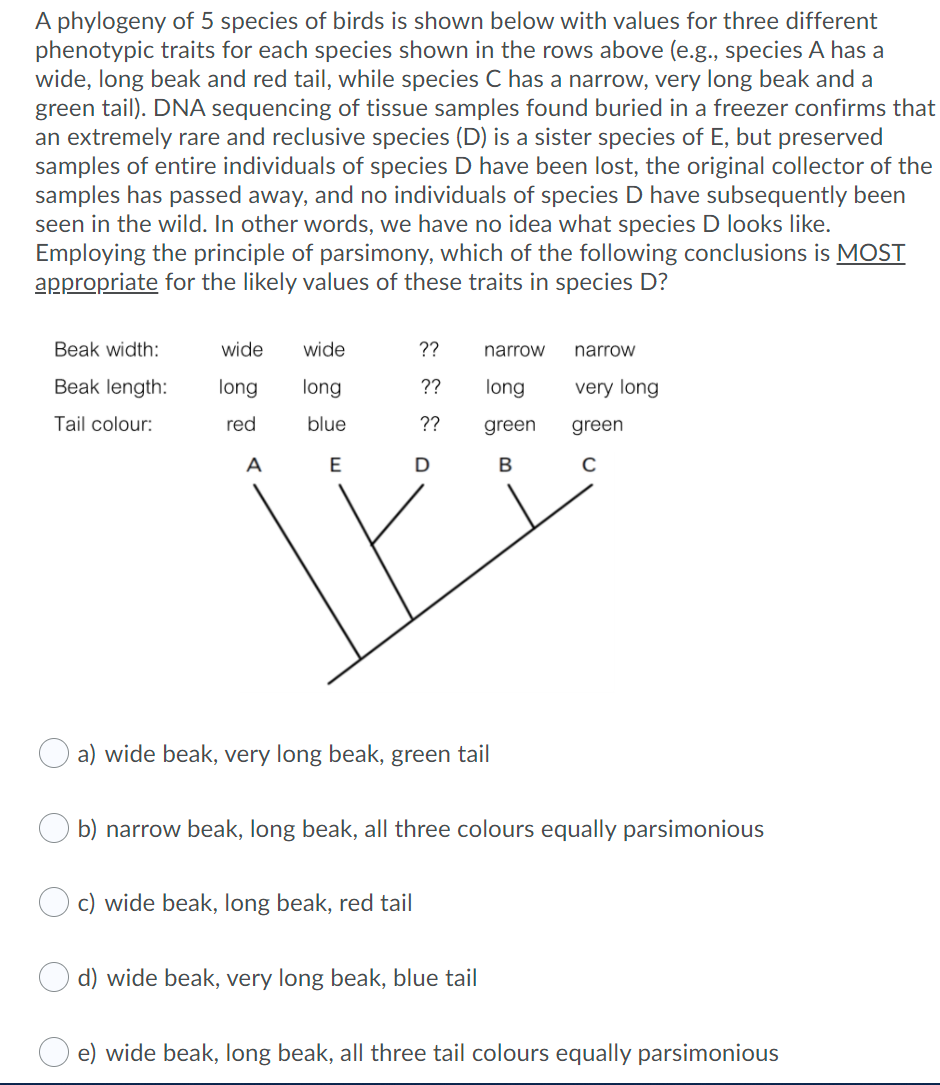A phylogeny of 5 species of birds is shown below with values for three different phenotypic traits for each species shown in the rows above (e.g., species A has a wide, long beak and red tail, while species C has a narrow, very long beak and a green tail). DNA sequencing of tissue samples found buried in a freezer confirms that an extremely rare and reclusive species (D) is a sister species of E, but preserved samples of entire individuals of species D have been lost, the original collector of the samples has passed away, and no individuals of species D have subsequently been seen in the wild. In other words, we have no idea what species D looks like. Employing the principle of parsimony, which of the following conclusions is MOST appropriate for the likely values of these traits in species D? Beak width: wide wide ?? narrow narrow Beak length: long long ?? long very long Tail colour: red blue ?? green green A a) wide beak, very long beak, green tail b) narrow beak, long beak, all three colours equally parsimonious c) wide beak, long beak, red tail d) wide beak, very long beak, blue tail e) wide beak, long beak, all three tail colours equally parsimonious
Evolution
The history and science of origin and evolution comprise two events, the beginning of life and expansion of life. Our earth originated about 4.5 billion years ago. The term evolution is derived from two Latin words and means the act of unfolding or unrolling. English philosopher Herbert Spencer first used it. Evolution is defined as the change in heritable traits of biological populations over successive generations. These traits are the manifestations of genes that are passed down from parent to offspring during reproduction.
Cladistics
Cladistics is a technique in the classification of organisms, where they are grouped into different clades. The proof for the relationships that are hypothesized is based on the shared derived characteristics known as synapomorphies. These characteristics do not exist in many of the distant ancestors and groups. The common ancestor along with its descendants is considered to be a part of the clade. The rate of closeness is directly proportional to the cladistic grouping and is useful in analyzing the evolutionary mechanism.
Outgroups
Outgroups are significant in studying cladistics or phylogenetics (that describe the evolutionary relationship between different organisms). Further, it is also important to understand the differences and similarities between different organisms.
Taxonomy
It is the branch of biology that works with the identification of organisms at first, then naming, and classification of them into phenetic or phylogenetic groups (a classification system). In other words, it is the scientific study of biological diversity and a part of systematic biology.
Phylogenetics
Phylogenetics is the scientific study of how various groups of organisms are related at the evolutionary level. It finds the relationship between various organisms based on their evolutionary similarities and differences. It is a part of the taxonomy. Although the taxonomic study is not only concerned about phylogeny but taxonomic studies are also concerned about the classification and nomenclature of the different individuals from different taxon.

Step by step
Solved in 2 steps


